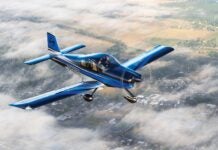One important step in preparing any kit for its first flight is getting an accurate weight and balance report. To do that, it’s time to roll the plane up on a set of calibrated scales. In this video, Larry Anglisano along with Mark Welch put a ready-to-fly Van’s RV-10 on the scales to get some numbers.














Weighing an RV-10 without its gear leg and wheel fairings seems likely to create a very strong temptation to use that data for the completed aircraft. And a builder who records and remembers only that ‘lightest ever’ weighing result. The more commonly recommended — and more honest — real world approach is to add the fairings sitting loosely at their installed positions, along with other things such as carpeting, seats and seat backs, and have those be part of the empty weight.
The aircraft was weighed with everything that will be on and in the aircraft for its first flight, with a planned reweighing and revision when it’s fully assembled.
Maybe they left out leveling the airplane for simplicity’s sake but the numbers for each wheel won’t be correct and the CG will not be accurate until weighed when level. Or am I missing something?
I agree. My RV-14A is 3 deg nose up which means to me I need to have the mains about an inch above the nose when on the scales.
Also I did not understand the raising the nose 10” and how the weight would be measured, i.e. applying downward weight on the tail changes overall weight of the aircraft.. Did you place a block under the nose wheel?
What is the function of cg height?
Why was the plane not put in flight level position?
Thanks!